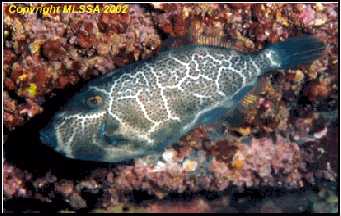
Marine Life Society of South Australia Inc.
Newsletter
August 2004
No. 313"understanding, enjoying & caring for our oceans"
Next Meeting
Our meeting will be held at the Conservation Centre, 120 Wakefield Street, Adelaide on Wednesday August 18th commencing at 7.30pm.
Our speaker will be Dr Kirsten Benkendorff from Flinders University. Her topic will be "Medicinal use of molluscs".
Contents
Just a brief note from Bicheno, Tasmania
Fish Sightings At Rapid Bay Jetty
Memories Of Tall Ships
Sustainable Seafood Guide (Page 2)
2005 Calendar
Contributors
This month our authors are Evan John, Steve Reynolds and AMCS personnel.
The results of the vote for the non-executive positions in MLSSA are as follows:
Editor: Philip Hall
SDF Rep.: Steve Reynolds
Con Council Rep.: Chris Hall
Reefwatch Rep.: Kevin Smith
Social Officer: Talitha Mascarenhas
Photo Index Officer: Steve Reynolds
Librarian: Steve Reynolds
Website Manager: Danny Gibbins
Auditor: Phill John
Sustainable Seafood Guide
This is the second of a two part publication I thank Craig Bohm of the Australian Marine Conservation Society for permission to publish them. Individual credits are on the pictures.
Just a brief note from Bicheno, Tasmania.
Today we visited a delightful little marine aquarium in a backyard shed almost, where a former fisherman and now turned environmentalist, is running a small marine business. His range of tanks contains a great variety of marine vertebrates and invertebrates from southern waters, even a tank of jellyfish, and his enthusiasm and ethos reminds me so much of MLSSA . He breeds seahorses, and has some aquaria arranged so that people can touch invertebrates ranging from feather stars to starfish to molluscs to hermit crabs. He also breeds mysiid shrimp for feeding seahorses and to supply Universities in Tassie. When I told him about MLSSA he was really interested (he had heard of MARIA). I include a picture of him and his setup, and his email address. His name is Bryan Hughes, and his email address is:
bichenoaquarium@tassie.net.au
Evan John
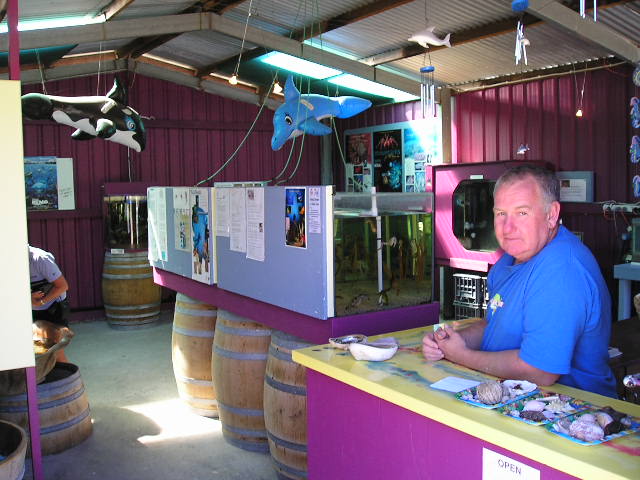
Fish Sightings At Rapid Bay Jetty
David may be quite right, there may be several Bluetail Leatherjackets, Eubalichthys cyanoura, at the Rapid Bay jetty. David said in his April article that he had seen a very large male Bluetail under the jetty’s T-junction on 26th February. Chris Hall and myself sighted a largish female closer to shore under the jetty on 13th April. I had seen it by the base of a jetty pile and called Chris over to see (and photograph) it. Unfortunately, it soon hid inside an arch-shaped hole by the base of the pile. It seemed to be about 30cm in length and had a distinct mosaic pattern. I don’t think that it could have been a male or the very large one that David had sighted previously. We enjoyed seeing ever so many other fish species there, including a few Leafy Seadragons, juvenile Scaly Fin and Black-banded Sea Perch. There were one or two magnificent Cardinal Fish which seemed to be glistening with gold fins. Just as we were about to walk back to the car park a fisherman hooked a large Leafy amid much excitement. We soon told him to return the fish to the sea since the species is protected. "What bait were you using?" said another fisherman. The one that had caught the Leafy wanted to have his photo taken by his friends before he would put it back into the sea. We suggested that he quickly drop it down from the lower divers’ platform. It wasn’t long before the Leafy was able to start swimming slowly back down to deeper water. None of the fishers seemed to know what the Leafy was and we could only wonder what would have happened to it if we had not been there.
Slide 1163 from the MLSSA Photo Index shows a female Bluetail.

Steve Reynolds
Slide 1163
Photographer:
David Muirhead
My first recollection of seeing tall ships was when I went with my parents to see some at Port Adelaide in 1988 as part of Australia’s Bicentenary celebrations. Living close to Port Adelaide now, I am able to see both the Falie and the One and All regularly.
The One and All
The One and All was built in SA and fitted out at Port Adelaide. She was based on a 1850s brigantine rig. A brigantine is said to be a "two-masted vessel with the fore mast being square-rigged, and the after mast fore and aft rigged". It is also described as being a "two-masted square-rigged vessel with additional fore and aft sail on mainmast". The 42.68m-long brigantine was launched at Port Adelaide in 1985. I first saw her a little after this. I was fortunate to have been visiting Port Adelaide on the day that the yardarms were fixed to her masts. She is a Sail Training Vessel so her full name is often given as the STV One and All.
She was one of four tall ships that took part in Encounter 2002 activities.
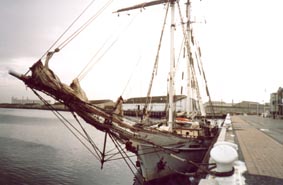
One particular memory that I still have about the is of the day that I was out off of Largs Bay beach in my old Zodiac inflatable dinghy with my wife Noeleen and two friends (ex-neighbours). The One and All was sailing out there and we chased after her, followed her and passed her. It was all great viewing for my passengers.
I seem to recall that although there was an earlier ketch called the One and All (built in 1878), the new One and All was based on a ketch called Post Boy, which had been built in Port Adelaide in 1874 and was wrecked (at Arno Bay?) in 1907. A ketch is a two-masted sailing vessel, rigged fore and aft, the after mast (mizzen) being shorter than the main mast. Only the aftermost mast of a ketch, yawl (ship’s boat or yacht), or three-masted ship is called a mizzen. The mizzen on a yawl is situated after the steering position.
The Falie
The Falie was built as an auxillary-engined schooner in Holland between 1919 and 1922, depending on whom you believe. She was named Hollands Trouw at the time. In 1922 or 3 she sailed to Port Adelaide where she was then registered. The Spencer Gulf Transport Company was then her owner. She was retired in 1982 and laid up before being bought by the SA Government for restoration. She was re-rigged as a ketch and is 45.72m-long. I think that I once witnessed the Falie docking at the Edithburgh jetty during a dive trip there several years ago. She conducts many trips for scuba divers. A group of divers can be seen in the photo of the Falie. Apart from being one of the four tall ships that took part in Encounter 2002 activities, the Falie also took part in SA’s Jubilee 150 celebrations in 1986.
The Enterprize
Encounter 2002 gave me the chance to see tall ships a great deal more. Four tall ships took part in Encounter 2002. They were the Enterprize, Falie, One and All and Young Endeavour. Although I am able to see the Falie and the One and All regularly at Port Adelaide, I couldn’t say the same for the Enterprize and the Young Endeavour.
When I attended the Encounter 2002 event at Wallaroo jetty on 16th March 2002, however, I witnessed the arrival of the Enterprize, along with the One and All, in front of a crowd of about 1,000 people. The two ships tied up at the Wallaroo jetty but we could not even get close to either of them. Later that day I sighted the two tall ships in Spencer Gulf sailing on towards Port Victoria for the next leg of Encounter 2002 proceedings.
The Enterprize is a replica of a Tasmanian topsail schooner that brought the first settlers to Melbourne in 1835. A schooner, apart from being a beer glass, is a small two-masted ship that is fore and aft rigged. A topsail schooner is a normal (fore & aft) rigged schooner carrying square sails on the top of the fore mast. The 27m Enterprize took eight years to build before being launched in 1997. She is said to be typical of an 1830s coastal trader. The Enterprize featured on a $1 postage stamp around 1999. Perhaps other tall ships did too.
The Young Endeavour
I also get ample opportunities to view other tall ships that visit Port Adelaide. The 44m-long brigantine Young Endeavour visited the Port recently. She was built at Lowestoft in England in 1986 and was Britain’s official Bicentennial gift to Australia in 1988. She is Australia’s official sail training ship so she is a Sail Training Vessel like the One and All which is also a brigantine. She is built of steel and her main mast’s height is 30m. She can reach speeds of 14 knots.
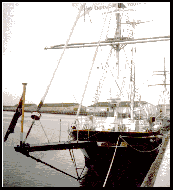
The New Endeavour
About one week before the Young Endeavour was due to arrive at the Port, another ship with a similar name sank in the area. It was the New Endeavour and she sank in No.1 dock. As far as I know, at the time of writing, she is still submerged in the dock, months after sinking there. The site there in No.1 dock is close to where the ex-HMAS Hobart had been moored for many months during scuttling preparations. This must have inspired a SA dive club which now wants to raise the ship (the New Endeavour) and sink it elsewhere as another dive wreck. Now wouldn’t that be great?
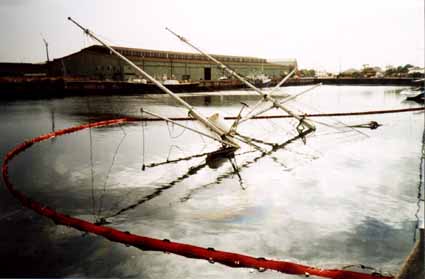
The Endeavour
Whilst discussing ships called Endeavour, I must make mention of the replica of the original Endeavour. Lieutenant James Cook was sailing in the HM Bark Endeavour when he found Australia’s East Coast in 1770. She was a three-masted ship of 368 tons. She was built in 1764 by Fishburn in Whitby, Yorkshire, England. She had three decks and her lower deck length was 97’ 7". Her overall length was 106 feet and her breadth was 29’ 3". Her main mast towered 100 feet above deck level. A full-scale replica of the ship was built in Fremantle, WA between 1988 and 1993. I have a book that details the building of this replica. In January 2001 she visited Port Adelaide whilst she was circumnavigating Australia. I believe that I saw her at that time although I do recall missing her do a mock sea battle with the One and All. It was all supposed to happen mid-week at Outer Harbour where I waited for hours with crowds of other people. In the meantime the whole battle was completed in the Inner Harbour and we missed the whole thing. The Endeavour left the Port a few days later to sail for Kingscote on Kangaroo Island. I think that she has been featured on an Australia Post postage stamp.
A bark (and barque) is said to be a vessel with both its fore mast and main mast square-rigged, and its after mast (mizzen) fore and aft rigged. A barquentine is said to be like a bark/barque except that its main mast is not square-rigged like they are.
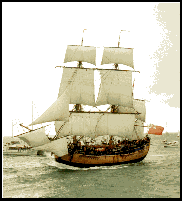
The Windeward Bound
As I drove home from work on 12th April 2003 I went over the Birkenhead Bridge at Port Adelaide. I could see that a ‘different’ tall ship was tied up on the Port River. A news report on television confirmed that the STV Windeward Bound was in the river. The next day I went down to the Port’s wharves for a look at the ship. I was able to take a photograph and pick up a couple of pamphlets about the ship. As her full title suggests, she is a Sail Training Vessel like the One and All. She is also a brigantine like both the One and All and the Young Endeavour. Although she has an overall length of 33m, her hull length is just 24m. Her overall length of 33m includes her bowsprit, the spar running forward from her bow. She had left Sydney Harbour on 7th March 2002 for a 16 to 17-month commemorative voyage around Australia, sailing anti-clockwise around the country. She left Port Adelaide on 8th May to sail to Victor Harbor.
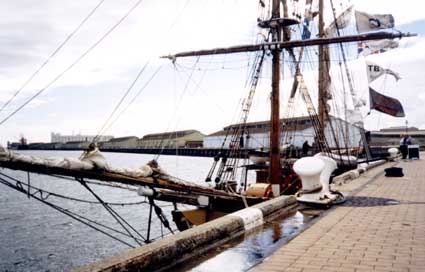
The Tribal Warrior
I also visited the (STV?) Tribal Warrior when she was in Port Adelaide in 2003. She is a sail training vessel like the One and All, Young Endeavour and Windeward Bound. She is also a ketch like the Falie. She is a gaff-rigged wooden ketch operated by the Tribal Warrior Association as a sail training vessel for Aborigines (Original Australians). The ketch is over 100 years old, having been built about 1899. The ship’s circumnavigation of Australia was the first such feat by an Australian Aboriginal vessel, crewed by about one dozen Aboriginal mariners. The fact that the ship sailed back into Sydney Harbour 200 years to the day that Flinders had done added greatly to the occasion.
The Rainbow Warrior
A few years ago Greenpeace brought their new Rainbow Warrior ship to Port Adelaide. Noeleen and I were given an enjoyable guided tour of the ship. This was the second Rainbow Warrior for Greenpeace since the first one had been blown-up whilst docked in New Zealand in 1985. A French SS agent planted two bombs on the ship which was then blown-up and sank. The name of the Rainbow Warrior is taken from a North American Indian prophecy. Greenpeace activities are well known worldwide. They have a fleet of ships (and boats) that are used at the forefront of their campaigns.
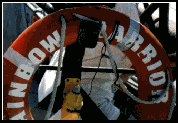
The Lady Nelson
When I visited Mount Gambier in both 1997 and 1998 I was able to see the full-size replica of the brig HMS Lady Nelson. The replica ship is on display at Lady Nelson Park (the Lady Nelson Tourist Interpretive Centre at the City of Mount Gambier’s Tourist Information Centre). The Tourist Information Centre is also known as "The Lady Nelson" Visitor Centre whilst the Tourist Interpretive Centre is also known as "The Lady Nelson" Discovery Centre. There is a neon sculpture of the Lady Nelson in the Visitor Centre. Visitors that tour the display of the replica ship in the Discovery Centre get to hear Lieutenant James Grant tell his story of discovery in the year 1800. The original Lady Nelson was a 60-ton brig built in England in 1799 specifically for exploration purposes. She was only 15m in length at the waterline. She sailed to Australia and is said to have been the first vessel to sail along the entire southern coastline of Australia. Further details about the voyages of the original Lady Nelson will be the subject of another article titled "Voyages Of The HMS Lady Nelson".
The 23m brig/brigantine* called the Lady Nelson that took part in the Hobart to Sydney Tall Ships Race in 1988 is apparently also a replica of the brig built in England in 1799. The Tall Ships Race was her inaugural voyage. She was a Class A vessel owned by Tasail, the Tasmanian Sail Training Association, and she went on to become a sail training ship in Tasmania.
*"Brig" is said to be an abbreviation of brigantine, the same as the One and All, Young Endeavour and Windeward Bound. As described at the beginning though, a brigantine is a "two-masted vessel with the fore mast being square-rigged, and the after mast fore and aft rigged". A brig, however, is described as being either a "two-masted square-rigged vessel with additional fore and aft sail on mainmast" or a "two-masted vessel square-rigged on both masts". A brigantine also has two masts like a brig but it is square-rigged on only the foremast. The after mast is fore and aft rigged.
For more information about some of the above tall ships check out their websites: -
One and All www.oneandall.org.au
Falie www.falie.com.au
Enterprize www.enterprize.com.au
Young Endeavour www.youngendeavour.gov.au
Tribal Warrior http://www.tribalwarrior.org .
Rainbow Warrior http://www.greenpeace.org/international_en/ships/
Pictures of the One and All, Young Endeavour, New Endeavour and Rainbow Warrior by Noeleen Reynolds.
Pictures of the Falie and Windward Bound by Steve Reynolds.
Picture of HM Bark Endeavour by Mark Churchman.
Steve Reynolds
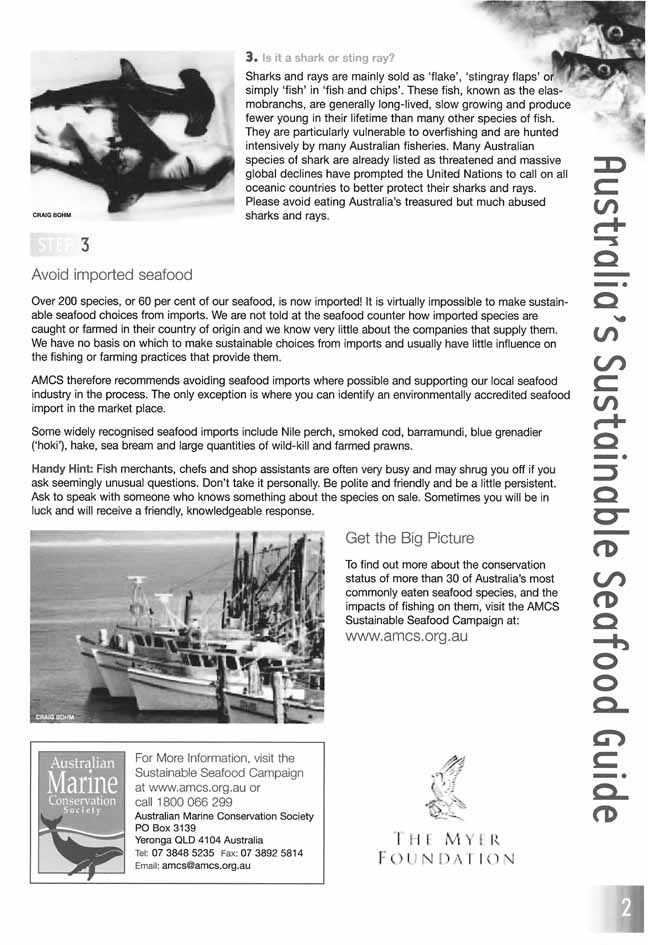
The 2005 Calendar is now available.
The cost is A$10 to non-members and A$8 to members.
We hope all members will take as many copies as possible to sell.